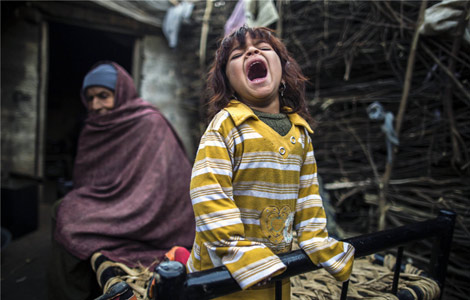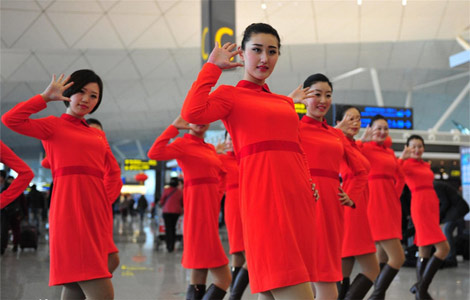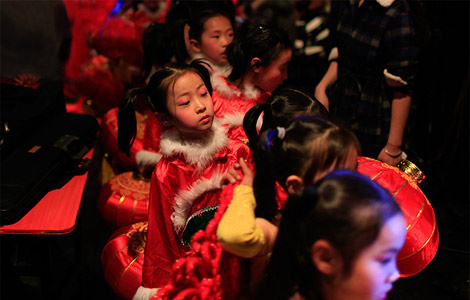
|
Models show off Lilanz's new products at a recent news conference. Provided to China Daily |
Hybrid design does the trick for apparel maker
When Hu Chengchu first heard the term "business and leisure" 13 years ago he says he had no idea what it meant.
These days there are few people who know more about it than Hu, executive director and vice-president of China Lilang Ltd, because his company, a menswear maker in Jinjiang, Fujian province, champions the design concept.
"I thought putting the two notions together was a case of comparing apples to oranges," Hu says.
But it was business and leisure that helped the company pull itself from the brink of bankruptcy and create one of the mainland's best menswear brands, one that has a place on the international stage.
Established in 1987, the company, which specialized in making Western-style suits, evolved into a well-known suit maker in the province and enjoyed great success in the early 1990s, when the suits market boomed and rivals were few.
The competition later became fiercer as more and more companies in the province looked for a piece of the action. Lilang's sales slumped in 1995, something for which it was not prepared, and five years later it was almost insolvent.
"Perhaps Lilang simply took its strong market position for granted," Hu says. "In any case, it did not react to change quickly enough, but I guess it's better late than never."
In an effort to turn things around, Wang Liangxing, Lilang's chief executive officer, traveled the country talking to business experts, academics and industry leaders in a quest for ideas.
While Lilang was well known in Fujian, it was little known beyond the province's borders, and on his trip, Wang says, he was frequently rebuffed or ignored.
Nevertheless, he was willing to wait for hours to talk to someone, a gritty persistence that eventually won many people over, Hu says.
The great lesson Wang learned was that product differentiation was the only solution, when faced with the cut-throat competition.
In 2001, Wang proposed the design idea of "business and leisure", based on his observation that dress is usually too formal on business occasions, which runs counter to the relaxing atmosphere that everybody wants to build.
The new concept aimed to let menswear present a lifestyle that combines simplicity and sophistication. It is targeted at the 28-45 age group, covering middle-class and white-collar customers.
To incorporate the concept into clothes, Lilang invited a prominent fashion designer, Ji Wenbo, to serve as its chief designer. The company also bought the latest equipment such as cuff sewing machines and a computer-aided design system from Europe to improve the quality of the clothes.
"With the concept and the production in place, the next important thing was to promote the brand," Hu says.
The company decided that the best way to do that was through celebrity endorsement, and Lilang found what Hu calls "Mr Right".
In 2002 the company managed to make Chen Daoming, a mainland actor known for his panache and for his low-key public profile, the spokesman for the menswear.
It proved to be a smart move, the star's endorsement helping boost sales.
In 1998, the company's turnover was about 12 million yuan ($2 million). After the ads featuring Chen were broadcast nationwide, the company's turnover reached more than 30 million yuan in 2002, Hu says.
Two years later, sales reached 100 million yuan, helped by heavy advertising on CCTV5, the sports channel, during the Olympic Games in Athens.
Riding this wave of success, the company would soon enjoy great exposure globally.
In 2007, the China National Garment Association chose Lilang as the country's only candidate to show a collection at Milan Fashion Week.
The organizing committee later issued a formal invitation, making Lilang China's first menswear brand to be shown at the prestigious event.
Ji Wenbo drew inspiration from the ancient terracotta warriors in Xi'an, which featured heavily in the design of the menswear.
The catwalk show featured jackets hued in Ji's trademark gray and black garnished with flashes of red and peacock blue, which gave a hint of ancient armor, and it reportedly wowed the audience.
Milan was merely a start. The rave reviews Lilang drew in the Italian fashion capital later catapulted the brand onto the stage of fashion weeks in Tokyo and Taipei.
While a frequent strategy for Chinese enterprises to go global is mergers and acquisitions, Lilang will not get into that act hurriedly, Hu says.
"The company may be involved in overseas mergers and acquisitions some day, but not now. It requires mutual understanding of the corporate culture and the local culture, and it takes time."
Instead, the company is focused on building its own brands and has kept moving with the times.
In 2008 Lilang changed the name of its eponymous flagship brand to Lilanz to make the brand more international. The following year it introduced L2, the second label on the market, targeted at the 20-35 age group.
In 2011 Lilang set up Lilanz advertising on billboards at Bangkok airport, targeting rich travelers. A year later, a new edition of an advertisement featuring Chen was filmed in New York, and the crew included the Hollywood movie maker Michael Fitzmaurice.
In the six months to June 30 last year, the company's turnover was 1.09 billion yuan, almost all of that attributable to sales of the core brand, Lilanz.
While the figures suggest a drop in sales compared with a year earlier, they were undoubtedly the result of a general lack of economic confidence, Hu says.
Nothing affected the brands' current status in the market, given Lilanz has more than 3,000 retail outlets and more than 200 L2 stores, scattered throughout second-tier and third-tier cities, Hu says.
"Again, the company may open stores overseas in the future, but the world needs to further recognize the brands and the culture first, and that's what Lilang has been working on."
Contact the writers at sunli@chinadaily.com.cn and liulu@chinadaily.com.cn
(China Daily Africa Weekly 01/24/2014 page16)








